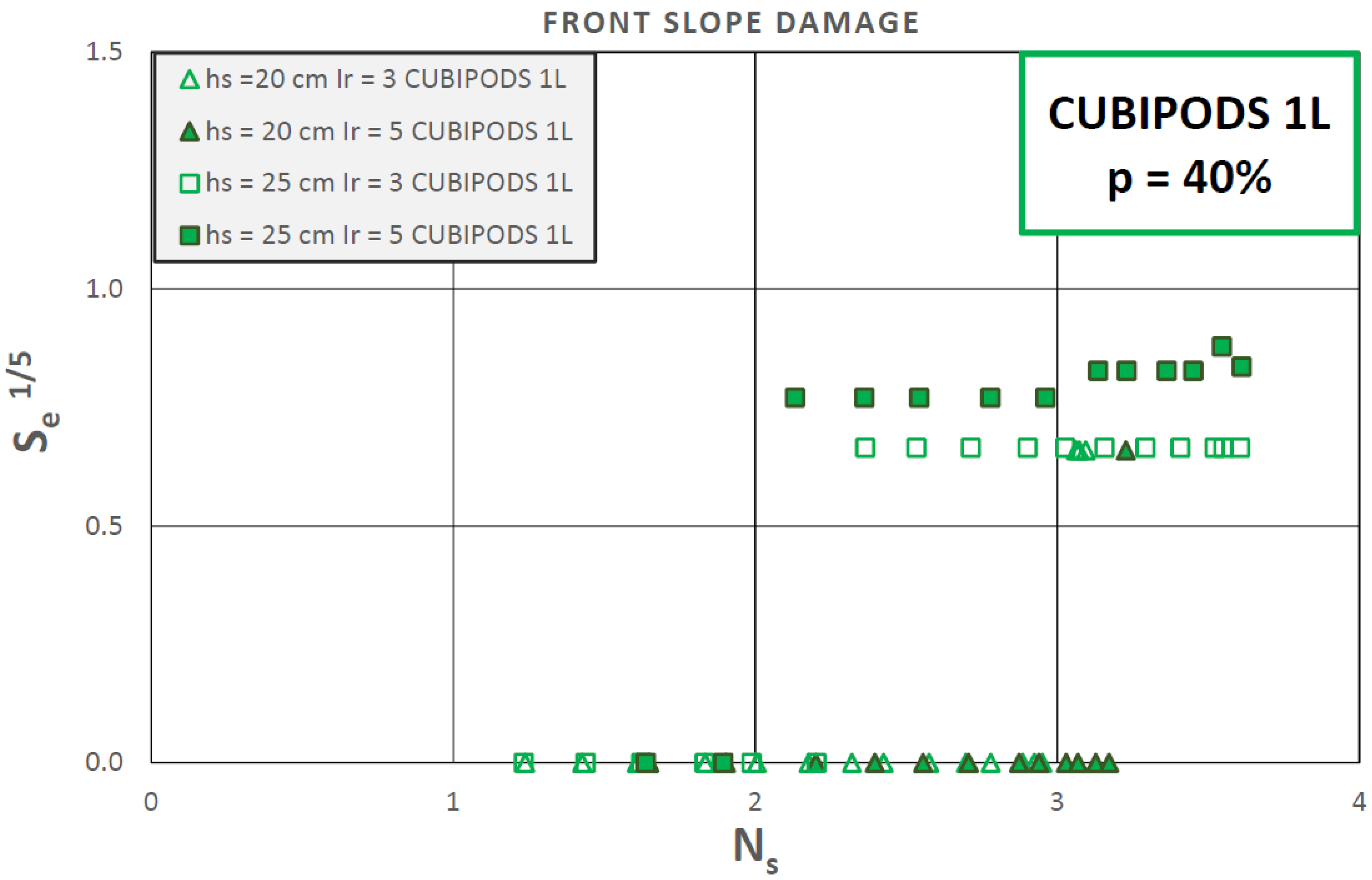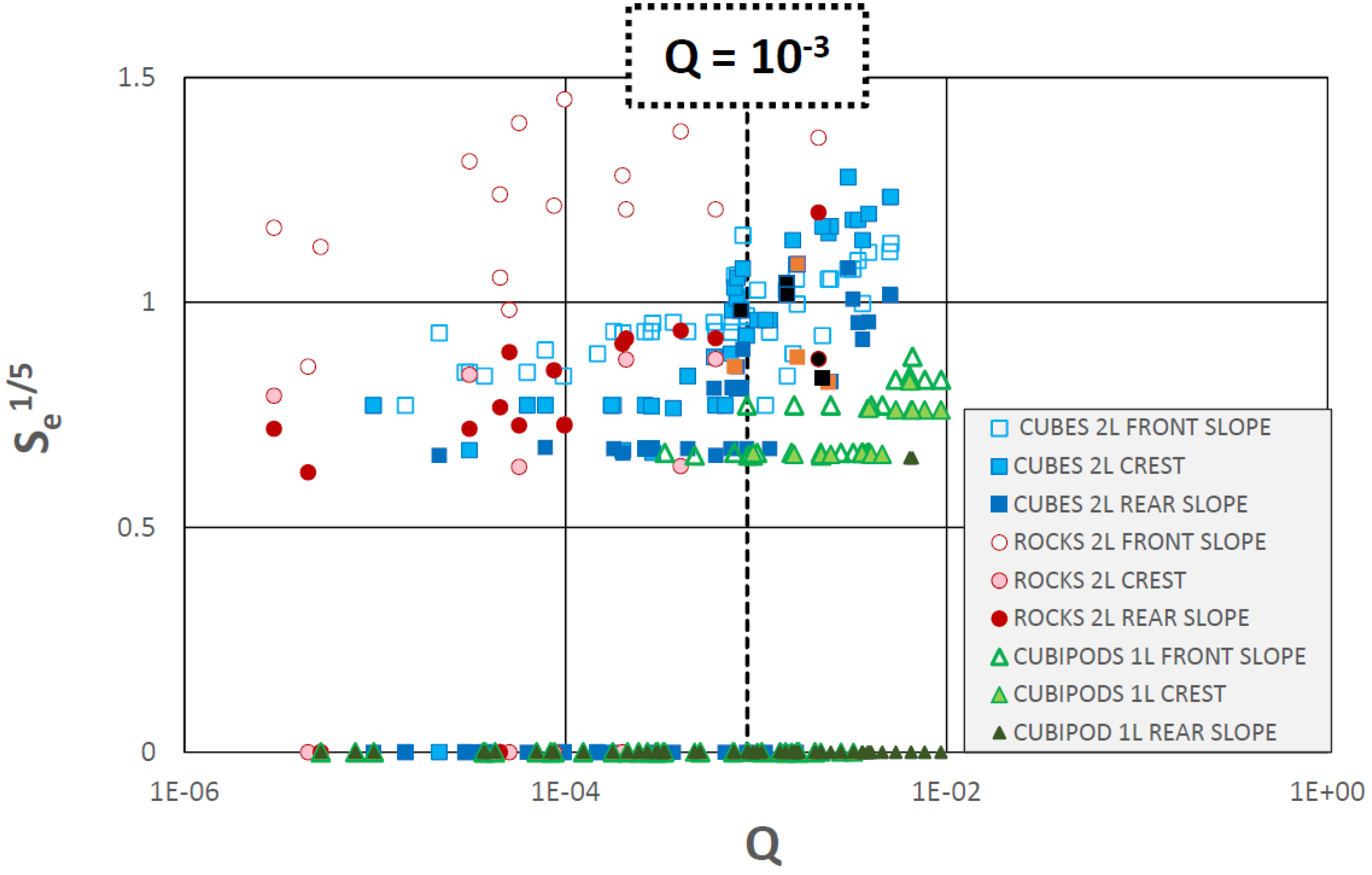Hydraulic Stability of the Armor Layer of Overtopped Breakwaters
Abstract
:1. Introduction
2. Literature Review
2.1. Hydraulic Stability of the Armor Layer
2.2. Armor Damage Measurement
3. Experimental Methodology
4. Analysis of Hydraulic Stability Test Results
4.1. Damage to Double-Layer Armors
4.2. Damage in Single-Layer Armors
4.3. Armor Damage and Overtopping Events
5. Conclusions
Author Contributions
Funding
Acknowledgments
Conflicts of Interest
References
- Pullen, T.; Allsop, N.W.H.; Bruce, T.; Kortenhaus, A.; Schüttrumpf, H.; van der Meer, J.W. EurOtop. Wave Overtopping of Sea Defences and Related Structures: Assessment Manual. Available online: www.overtopping-manual.com (accessed on 20 October 2018).
- Kramer, M.; Burcharth, H.F. Stability of low-crested breakwaters in shallow water short crested waves. Proc. Coast. Struct. 2003, 137–149. [Google Scholar] [CrossRef]
- Burcharth, H.F.; Kramer, M.; Lamberti, A.; Zanuttigh, B. Structural stability of detached low crested breakwaters. Coast. Eng. 2006, 53, 381–394. [Google Scholar] [CrossRef] [Green Version]
- CIRIA/CUR/CETMEF. The Rock Manual. The Use of Rock in Hydraulic Engineering, 2nd ed.; CIRIA: London, UK, 2007; 1267p. [Google Scholar]
- Hudson, R.Y. Laboratory investigations on rubble mound breakwaters. J. Waterw. Harb. Div. ASCE 1959, 85, 93–121. [Google Scholar]
- Van der Meer, J.W. Rock Slopes and Gravel Beaches under Wave Attack. Ph.D Thesis, Delft Technical University, Delft, The Netherlands, 1988. [Google Scholar]
- Herrera, M.P.; Gómez-Martín, M.E.; Medina, J.R. Hydraulic stability of rock armors in breaking conditions. Coast. Eng. 2017, 127, 55–67. [Google Scholar] [CrossRef]
- Van der Meer, J.W.; Daemen, I.F.R. Stability and wave transmission at low-crested rubble mound structures. J. Waterw. Port Coast. Ocean Eng. 1994, 120, 1–19. [Google Scholar] [CrossRef]
- Vidal, C.; Losada, M.A.; Medina, R.; Mansard, E.P.D.; Gómez-Pina, G. A universal analysis for the stability of both low-crested and submerged breakwaters. In Proceedings of the 23rd Conference on Coastal Engineering, ASCE, Venice, Italy, 4–9 October 1992; pp. 1679–1692. [Google Scholar]
- Burger, G. Stability of low-crested breakwaters. Final Proceedings 1995. EU research project Rubble mound breakwater failure modes, MAST 2 contract MAS2-CT92-0042. Delft Hydraulic Report H1878/H2415. Coast. Eng. 2006, 53, 381–394. [Google Scholar]
- Vidal, C.; Medina, R.; Martín, F.L. A methodology to assess the armor stability of low-crested and submerged breakwaters. Coast. Struct. 1999, 2, 721–725. [Google Scholar]
- Vidal, C.; López, F.; Losada, I. Stability of low crested and submerged rubble mound breakwaters. Proc. Coast. Struct. 2007, 2, 939–950. [Google Scholar]
- Gómez-Martín, M.E.; Medina, J.R. Heterogeneous packing and hydraulic stability of cube and Cubipod armor units. J. Waterw. Port Coast. Ocean Eng. 2014, 140, 100–108. [Google Scholar] [CrossRef]
- Losada, M.A.; Desiré, J.M.; Alejo, L.M. Stability of blocks as breakwater armor units. J. Struct. Eng. 1986, 112, 2392–2401. [Google Scholar] [CrossRef]
- Vidal, C.; Losada, M.A.; Medina, R. Stability of mound breakwaters’ head and trunk. J. Waterw. Port Coast. Ocean Eng. 1991, 117, 570–587. [Google Scholar] [CrossRef]
- Gómez-Martín, M.E. Análisis de la Evolución de Averías en el Manto Principal de Diques en Talud Formado por Escolleras Cubos y Cubípodos. Ph.D. Thesis, Universitat Politècnica de València, Valencia, Spain, 2015. [Google Scholar]
- Mansard, E.P.D.; Funke, E.R. The measurement of incident and reflected spectra using a least squares method. In Proceedings of the 17th International Conference on Coastal Engineering, ASCE, Sydney, Australia, 23–28 March 1980; pp. 154–172. [Google Scholar]
- Figueres, M.; Medina, J.R. Estimation of incident and reflected waves using a fully non-linear wave model. In Proceedings of the 29th International Conference on Coastal Engineering, Lisbon, Portugal, 19–24 September 2004; pp. 594–603. [Google Scholar]
- Verhagen, H.J.; Van Vledder, G.; Eslami Arab, S. A practical method for design of coastal structures in shallow water. In Proceedings of the 31st International Conference on Coastal Engineering, Hamburg, Germany, 31 August–5 September 2008; Volume 4, pp. 2912–2922. [Google Scholar]
- Medina, J.R.; Hudspeth, R.T.; Fassardi, C. Breakwater Armor Damage due to wave groups. J. Waterw. Port Coast. Ocean Eng. 1994, 120, 179–198. [Google Scholar] [CrossRef]













| Layer | M50 (g) | ρr (g/cm3) | Dn50 (cm) |
|---|---|---|---|
| Core | 0.86 | 2.72 | 0.68 |
| Filter | 15.40 | 2.73 | 1.78 |
| Rocks | 86.77 | 2.68 | 3.18 |
| Cubes | 141.51 | 2.27 | 3.97 |
| Cubipods | 121.25 | 2.22 | 3.79 |
| Series | Armor Layer | hs (cm) | Irp | S0p | Hm0 (cm) | Tp (s) | Rc (cm) | Nt | Ntw |
|---|---|---|---|---|---|---|---|---|---|
| 1 | Cubipods 1L | 20 | 3 | 0.049 | 8–24 | 1.02–1.76 | 12 | 17 | 17,000 |
| 2 | Cubipods 1L | 20 | 5 | 0.018 | 8–20 | 1.70–2.68 | 12 | 13 | 13,000 |
| 3 | Cubipods 1L | 25 | 3 | 0.049 | 8–24 | 1.02–1.76 | 7 | 17 | 17,000 |
| 4 | Cubipods 1L | 25 | 5 | 0.018 | 8–20 | 1.70–2.68 | 7 | 13 | 13,000 |
| 5 | Rocks 2L | 20 | 3 | 0.049 | 8–16 | 1.02–1.44 | 15 | 9 | 9000 |
| 6 | Rocks 2L | 20 | 5 | 0.018 | 8–13 | 1.70–2.08 | 15 | 6 | 6000 |
| 7 | Rocks 2L | 25 | 3 | 0.049 | 8–16 | 1.02–1.44 | 10 | 9 | 9000 |
| 8 | Rocks 2L | 25 | 5 | 0.018 | 8–13 | 1.70–2.08 | 10 | 6 | 6000 |
| 9 | Cubes 2L | 25 | 3 | 0.049 | 8–24 | 1.02–1.76 | 11 | 17 | 17,000 |
| 10 | Cubes 2L | 25 | 5 | 0.018 | 8–20 | 1.70–2.68 | 11 | 13 | 13,000 |
| 11 | Cubes 2L | 30 | 3 | 0.049 | 8–24 | 1.02–1.76 | 6 | 17 | 17,000 |
| 12 | Cubes 2L | 30 | 5 | 0.018 | 8–14 | 1.70–2.25 | 6 | 7 | 7000 |
| Armor Layer | Sector | k1 (Equation (5)) | k2 (Equation (5)) | rMSE | r |
|---|---|---|---|---|---|
| Rocks 2L | Front slope | 0.633 | −0.056 | 0.095 | 0.949 |
| Cubes 2L | Front slope | 0.137 | 0.621 | 0.253 | 0.861 |
| Cubes 2L | Crest | 0.240 | 0.362 | 0.290 | 0.838 |
| Cubes 2L | Rear slope | 0.255 | 0.113 | 0.461 | 0.716 |
| Armor Layer | Sector | sop | Ns | |
|---|---|---|---|---|
| Rocks 2L | Front slope | 0.018–0.049 | 1.36–2.28 | 3.73–4.66 |
| Cubes 2L | Front slope | 0.018–0.049 | 1.18–3.54 | 4.96–5.95 |
| Cubes 2L | Crest | 0.018–0.049 | 1.37–3.54 | 4.96–5.95 |
| Cubes 2L | Rear slope | 0.018–0.049 | 2.58–3.54 | 4.96–5.95 |
© 2018 by the authors. Licensee MDPI, Basel, Switzerland. This article is an open access article distributed under the terms and conditions of the Creative Commons Attribution (CC BY) license (http://creativecommons.org/licenses/by/4.0/).
Share and Cite
Argente, G.; Gómez-Martín, M.E.; Medina, J.R. Hydraulic Stability of the Armor Layer of Overtopped Breakwaters. J. Mar. Sci. Eng. 2018, 6, 143. https://doi.org/10.3390/jmse6040143
Argente G, Gómez-Martín ME, Medina JR. Hydraulic Stability of the Armor Layer of Overtopped Breakwaters. Journal of Marine Science and Engineering. 2018; 6(4):143. https://doi.org/10.3390/jmse6040143
Chicago/Turabian StyleArgente, Gloria, M. Esther Gómez-Martín, and Josep R. Medina. 2018. "Hydraulic Stability of the Armor Layer of Overtopped Breakwaters" Journal of Marine Science and Engineering 6, no. 4: 143. https://doi.org/10.3390/jmse6040143






